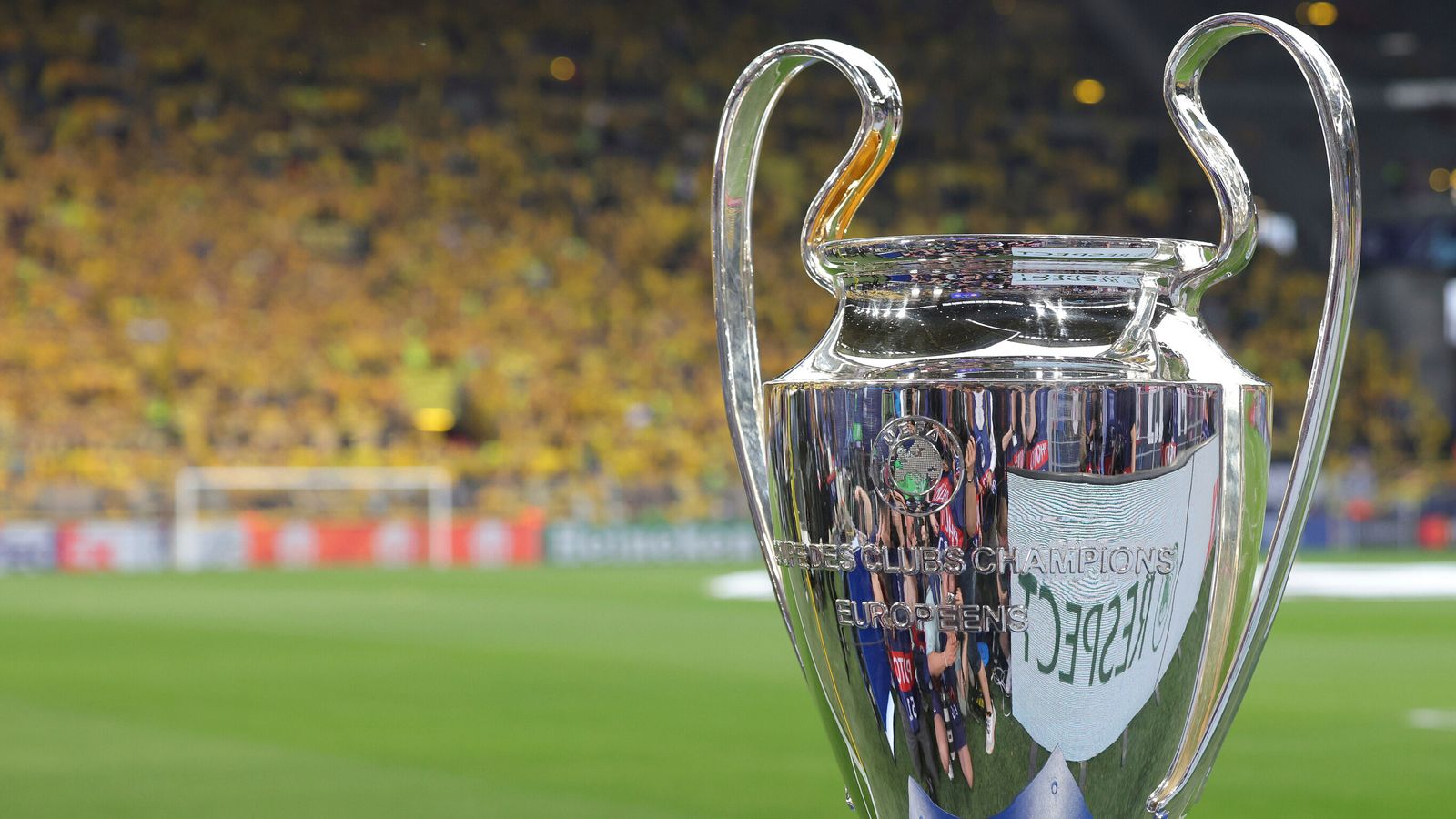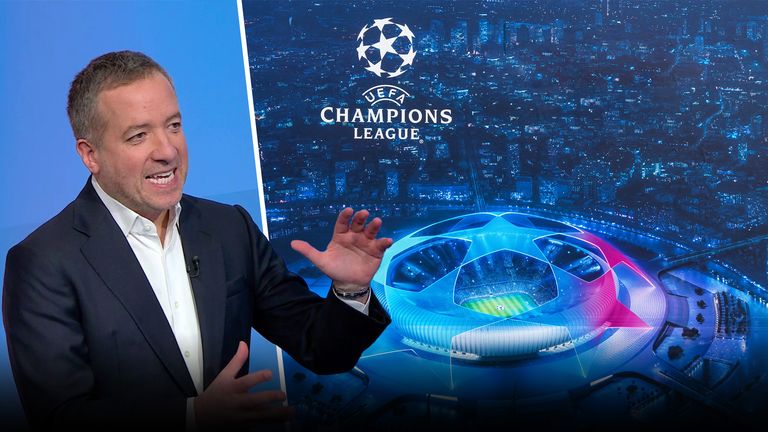The Champions League has undergone a drastic revamp ahead of the 2024/25 season which sees the number of matches in the new format increase from 125 to 189.
The league phase will now be completed at the end of January instead of during December, while there will be weeks exclusively dedicated to the Champions League in the football calendar when no other European competitions are played.
The winners will have played 17 games across the competition, while matches played across Tuesday, Wednesday and Thursday in Europe’s premier club competition will become the new normal.
At least 10 of next season’s 36 clubs participating in the new league phase will come from Italy and Germany. Sky Sports provides you with a comprehensive guide to how the new format will work…
When is the draw for the league phase?
The draw for the league phase will be held on August 29.
How does the new Champions League format work?
Taking the total number of teams from 32 to 36 in the Champions League, the biggest change will see a transformation from the traditional group stage to a single league phase including all participating teams.
Every club will now be guaranteed a minimum of eight league-stage games against eight different opponents (four home games, four away) rather than the previous six matches against three teams, played on a home-and-away basis.
The top eight sides in the league will qualify automatically for the knockout stages, while the teams finishing in ninth to 24th place will compete in a two-legged play-off to secure a place in the last 16 of the competition.
Teams ranked 25-36 are eliminated from all competitions.
OK, but how does the draw work in practice?
First of all, why the change? Well, if the old draw concept for the group stage were to be applied to the new league phase format, nearly 1,000 balls would be required with at least 36 bowls on stage.
Even those who love a draw will realise that would be unbearably long. So UEFA is going to use a supercomputer to generate most of the work.
First, all 36 teams will be manually drawn with a physical ball on stage.
Then, for every team manually drawn, a designated automated software will randomly draw eight opponents across the four pots – to be shown on screen and on stage at the Grimaldi Forum in Monte Carlo for all to see.
The software will then decide which fixtures are home and away.
The draw will start with Pot 1 (containing the strongest teams and current holders of the Champions League) and work down through the four pots.
Then what?
The 36 clubs will be seeded into four different pots based on their individual club coefficient at the start of the season.
Each team will be drawn against two different teams from each pot, playing one team at home and one away.
Teams will play eight matches against eight different teams.
When will fans know the fixture dates?
The finalised fixture list will be released on Saturday August 31.
How many teams can you face from any one nation?
In the league phase, teams cannot face opponents from their own country and can face a maximum of two sides from the same country.
Which teams have qualified for the league phase?
Shakhtar Donetsk and Benfica have qualified by virtue of the Champions League and Europa League winners having already qualified via their domestic league performance or as a result of their country’s collective performance in Europe this season.
We are still in the midst of the qualifying rounds, but here are the teams guaranteed to enter the league phase:
- UEFA Europa League winners: Atalanta
- England: Man City, Arsenal, Liverpool, Aston Villa
- Spain: Real Madrid, Barcelona, Girona, Atletico Madrid
- Germany: Leverkusen, Stuttgart, Bayern, Leipzig, Dortmund
- Italy: Inter Milan, AC Milan, Bologna, Juventus
- France: Paris Saint-Germain, Monaco, Brest
- Netherlands: PSV Eindhoven, Feyenoord
- Portugal: Sporting CP
- Belgium: Club Brugge
- Scotland: Celtic
- Austria: Sturm Graz
- Champions League winner rebalancing: Shakhtar Donetsk
- Europa League winner rebalancing: Benfica
Based on UEFA coefficients, what do the projected pots look like?
Pot One – Man City, Bayern Munich, Real Madrid, PSG, Liverpool, Inter Milan, Borussia Dortmund, RB Leipzig, Barcelona
Pot Two – Bayer Leverkusen, Atletico Madrid, Atlanta, Juventus, Benfica, Arsenal, Club Brugge, Shakhtar Donetsk, AC Milan
Pot Three – Feyenoord, Sporting CP, PSV, Lille*, PAOK*, Young Boys*, Celtic, Galatasaray*, Union SG*
Pot Four – Midtylland*, AS Monaco, Sparta Prague*, Aston Villa, Bologna, Girona, Stuttgart, Sturm Graz, Stade Brestois
* Clubs yet to advance through qualifying rounds – clubs with highest UEFA coefficients included here
What about the qualifying rounds?
Seven teams will enter via winning a two-legged play-off.
Rangers are entering the third qualifying round, and have been drawn to face Dynamo Kyiv. The first leg is on Tuesday August 6 with the return a week later on August 13.
Philippe Clement’s side are one of the seeded clubs along with Slavia Prague, Red Bull Salzburg and Lille. Should Rangers prevail, they will have their sights set on the play-off round.
The first legs of those take place on August 20-21 with the return legs on August 27-28.
Which nations gained the extra places?
Two leagues – Italy and Germany – have been rewarded with an extra place in next season’s Champions League based on performance in Europe this season.
This was based around the best average coefficient of all teams participating in Europe for each country. The two leagues with the best score received an extra place.
Atalanta have secured at least a fourth-placed finish in the Italian top flight following a 3-0 victory over Torino last weekend.
The result also ruled out the possibility of a sixth Serie A spot qualifying for the Champions League next season.
When are the 2024/25 Champions League league-stage matches?
- Matchday 1: September 17-19, 2024
- Matchday 2: October 1/2, 2024
- Matchday 3: October 22/23, 2024
- Matchday 4: November 5/6, 2024
- Matchday 5: November 26/27, 2024
- Matchday 6: December 10/11, 2024
- Matchday 7: January 21/22, 2025
- Matchday 8: January 29, 2025
When are the 2024/25 Champions League knockout stages?
- Knockout round play-offs: February 11/12 and February 18/19, 2025
- Round of 16: March 4/5 and March 11/12, 2025
- Quarter-finals: April 8/9 and April 15/16, 2025
- Semi-finals: April 29/30 and May 6/7, 2025
- Final: May 31, 2025
Where is the Champions League final being held in 2025?
The 2024/25 UEFA Champions League season will take place in Munich at the Allianz Arena on May 31, 2025.
Europa League and Europa Conference League changing too?
Similar changes will be made to the Europa League and Europa Conference League formats, with 36 teams in each.
Teams in the Europa League will have eight matches against eight different opponents in the league phase.
In the Europa Conference League – renamed the UEFA Conference League – teams will have six matches against six different opponents in the league phase. The UEFA Conference League games will be played between September and December.
The knockout phases of the competitions will take place through the second half of the season and culminate at the end of the campaign, as they do now.







